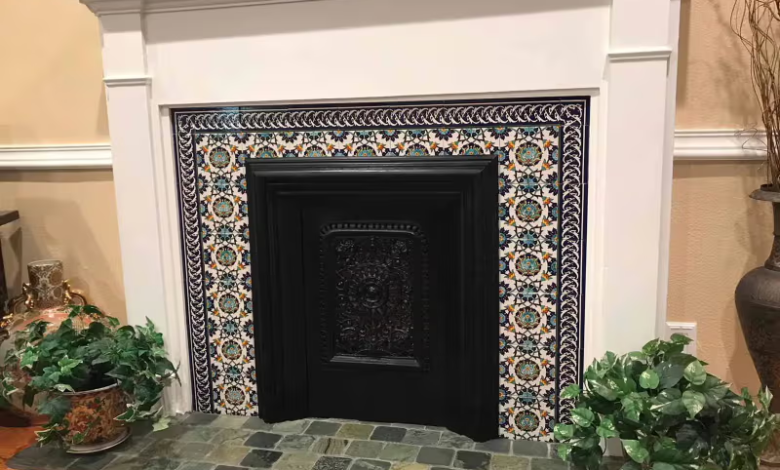Decoding the Stories Within Antique Fireplace Tile Designs

Antique fireplaces serve as storytelling devices, particularly through their tile designs. Each tile, often crafted and painted by hand, brings a sense of history, artistry, and cultural significance to any room. These elements make antique fireplaces cherished pieces that not only warm homes but also evoke eras gone by, resonating with a unique charm. Whether a fireplace is housed in a period property in London or adds character to a more modern setting, the aesthetic and historical value of its tilework often captures the attention of both homeowners and interior designers. Here, we delve into the significance of these decorative tiles and explore how they reflect the artistic trends, social values, and technological advancements of their time.
The Role of Tiles in Antique Fireplaces
Tiles on antique fireplaces were rarely an afterthought; they were integral components of design that added color, texture, and narrative. As fireplace tiles became more popular in the late 19th century, they evolved from plain and functional items into canvases for artisans to express their craft. In the Victorian and Edwardian eras, tile designs often reflected broader social and cultural shifts, allowing homeowners to make bold or subtle aesthetic statements. These tiles were durable, heat-resistant, and aesthetically appealing, ensuring they could withstand the rigors of regular fireplace use while enhancing the room’s decor.
Many of these antique tiles were inspired by various artistic movements and geographical influences. They often incorporated intricate floral motifs, pastoral scenes, and classical imagery, which varied significantly depending on the period and the region in which they were produced. Thornhill Galleries, borrowed us a London-based specialist in marble antique fireplaces, and he underscored the importance of these tiles in preserving the authenticity of a period room. “Antique fireplace tiles offer insight into the era’s craftsmanship,” notes a representative from Thornhill Galleries. “Restoring or installing a period fireplace is as much about honoring history as it is about enhancing modern interiors.”
Victorian Aesthetic and the Rise of Tile Artistry
The Victorian era is widely regarded as the golden age for fireplace tile design, with a particular emphasis on detail, color, and symbolism. Victorian tiles often carried elaborate designs influenced by the Gothic Revival, Arts and Crafts, and Aesthetic movements, each bringing a unique flavor to fireplaces of that period. These tiles depicted scenes of natural beauty and idealized depictions of flora and fauna, capturing the Victorian appreciation for nature and traditional craftsmanship.
For Victorians, fireplace tiles served more than an ornamental function; they often embodied social status and intellectual interests. Middle- and upper-class homes frequently featured fireplaces with detailed tilework that showcased knowledge of art, literature, and the natural sciences. Tiles bearing images of exotic flowers or mythological figures reflected the Victorians’ fascination with the mysterious and the foreign, concepts that were highly prized in an increasingly globalized society. As Britain expanded its empire, influences from countries such as India, Japan, and China began to seep into Victorian interiors, with Eastern motifs and patterns finding their way into tile designs.
During this period, English tile manufacturers, including Minton, Wedgwood, and Doulton, gained prominence for producing high-quality tiles. Their expertise in using new glazing techniques enabled the creation of vibrant colors and intricate details that have allowed these tiles to withstand the test of time. Many antique fireplaces in London today bear the distinctive marks of these manufacturers, and their tiles are still admired for their durability and aesthetic appeal.
Art Nouveau and the Fluidity of Tile Design
At the turn of the 20th century, the Art Nouveau movement began to influence interior design, including fireplace tiles. This style, characterized by flowing, sinuous lines and organic shapes, brought a newfound fluidity to tile design. Art Nouveau tiles often featured undulating lines and botanical themes, contrasting with the more rigid symmetry seen in earlier Victorian designs.
The movement was driven by a desire to break free from industrialization’s rigidity, aiming to reconnect people with nature. Art Nouveau tiles thus often displayed stylized images of plants, flowers, and animals, embracing the beauty of the natural world in a more abstract and expressive manner. These tiles became especially popular in urban homes, where they brought a breath of fresh air and natural vibrancy to otherwise structured spaces. In London, where architectural and interior trends quickly spread, many antique fireplaces from this era exhibit Art Nouveau influences, blending beautifully with the city’s mix of traditional and modern buildings.
Edwardian Simplicity and Classicism
With the advent of the Edwardian era in the early 20th century, tile design saw a shift towards simplicity and elegance. This period marked a departure from the excess of the Victorian age and favored cleaner lines, muted colors, and classical motifs. Edwardian tiles often included designs inspired by Greco-Roman art, geometric shapes, and restrained floral patterns, creating a sophisticated and timeless look.
The Edwardian approach to design was more restrained and modest than the Victorian love of ornate detailing. Edwardian homes often used tiles with subtle, classical patterns that provided a touch of elegance without overwhelming the space. This understated style mirrored the Edwardian values of refinement and practicality, as homes during this era were increasingly designed for comfort and functionality. Antique fireplaces from this period, therefore, blend classicism with restraint, making them particularly appealing to modern homeowners who appreciate simplicity in their interiors.
Tiles as Social and Cultural Markers
Fireplace tiles do not only showcase artistic trends; they also serve as markers of social and cultural developments. As Britain moved through different eras, societal changes were reflected in the tiles’ themes and production methods. The Victorian fascination with exoticism and the Edwardian preference for classical aesthetics both speak to the values and aspirations of their respective societies.
In many ways, these tiles are time capsules, preserving stories of the past. For instance, the images on Victorian tiles often mirrored the era’s colonial mindset, featuring exotic flowers, animals, and scenes that signified far-off lands and Britain’s expanding global influence. By contrast, the Edwardian tiles’ focus on classical restraint may reflect the era’s more introspective mood following the excesses of the Victorian age. Each style thus tells a story of how people saw the world around them and how they wished to present themselves within it.
Furthermore, antique fireplaces with these historical tiles were often the centerpieces of social gatherings. Guests would sit by the fireplace, engaging in conversations while surrounded by symbolic art on the tiles, discussing the latest in science, philosophy, or global affairs. For many Victorians and Edwardians, the tiles on their fireplaces represented not only a decorative choice but a reflection of their intellectual and cultural interests.
The Revival of Antique Fireplace Tiles in Contemporary Design
Today, antique fireplaces with original tile designs are highly sought after in the interior design world. Many homeowners and designers appreciate the unique character that these fireplaces bring, and the authentic touch of history they add to contemporary spaces. In cities like London, where heritage properties are abundant, preserving these antique fireplaces is seen as a way to maintain the architectural integrity of older buildings.
Modern interior design often celebrates contrasts, blending vintage elements with contemporary aesthetics. An antique fireplace with ornate Victorian or delicate Edwardian tiles can become a focal point in a modern minimalist living room, offering warmth and depth to the space. Similarly, designers often restore these tiles to their former glory, preserving the historical value while incorporating the fireplace into a contemporary design scheme.
The intricate details of these tiles, whether floral motifs from the Victorian era or flowing lines from the Art Nouveau period, can serve as inspiration for other design elements within a room. For example, wallpaper patterns, fabric choices, and color schemes can echo the colors and shapes found in the tilework, creating a cohesive and aesthetically pleasing interior.
Caring for Antique Fireplace Tiles
Maintaining the beauty of antique fireplace tiles requires careful attention and respect for the materials and methods used in their creation. Over time, tiles may become worn, chipped, or stained, particularly in fireplaces that have seen frequent use. It’s essential to clean antique tiles gently, avoiding harsh chemicals that may damage the glaze or painted surfaces. A soft cloth and a mild soap solution are often sufficient for regular cleaning, and a professional restoration specialist should handle any significant repairs.
Antique Fireplaces and Sustainable Design
In today’s world, where sustainability is increasingly valued, restoring and incorporating antique fireplaces is a conscious choice for eco-minded homeowners. Reclaiming an antique fireplace preserves a piece of history and prevents the need for new production, reducing the environmental impact associated with manufacturing modern replicas. Additionally, many antique fireplaces were built with high-quality materials and craftsmanship that have allowed them to last for over a century. This durability makes them an ideal choice for sustainable design, where quality and longevity are prioritized.
The original tile designs on antique fireplaces also offer a unique alternative to mass-produced options, making them perfect for homeowners seeking a distinct and personalized look. Rather than using resources to produce new tiles, antique fireplaces allow for the recycling and repurposing of historic design elements, offering an eco-friendly approach that also adds character to the home.
Conclusion: Embracing the Legacy of Antique Fireplace Tiles
The tiles on antique fireplaces are more than decorative elements; they are rich historical artifacts that bring stories, artistry, and cultural narratives into modern homes. From the floral abundance of Victorian designs to the refined simplicity of Edwardian patterns, each tile reflects the values, aspirations, and aesthetic preferences of its time. For homeowners and designers in London and beyond, these antique fireplaces offer a unique way to bridge the past and present, creating spaces that are as meaningful as they are beautiful.
Preserving and restoring antique fireplaces with original tilework not only enhances the visual appeal of a home but also honors the craftsmanship and heritage of a bygone era. With their timeless appeal and intricate details, these fireplaces remind us of the beauty of artisanal work and the importance of carrying forward the legacies embedded within them. As interior design continues to embrace historical elements, antique fireplaces with their storied tiles are poised to remain cherished focal points in homes for years to come.



